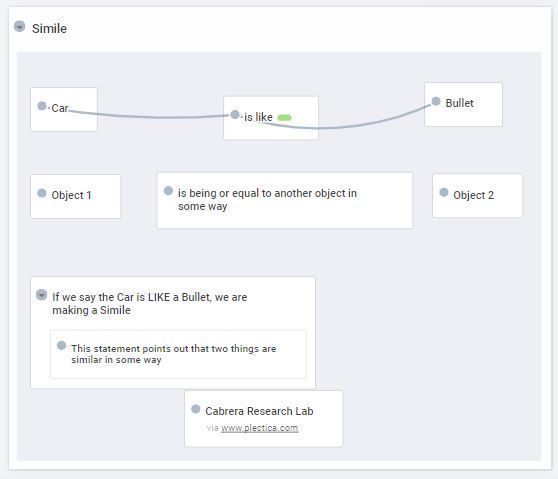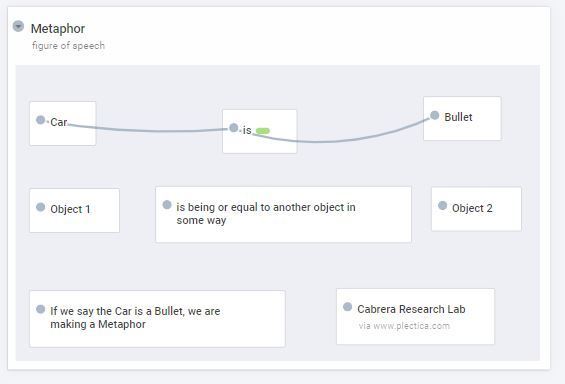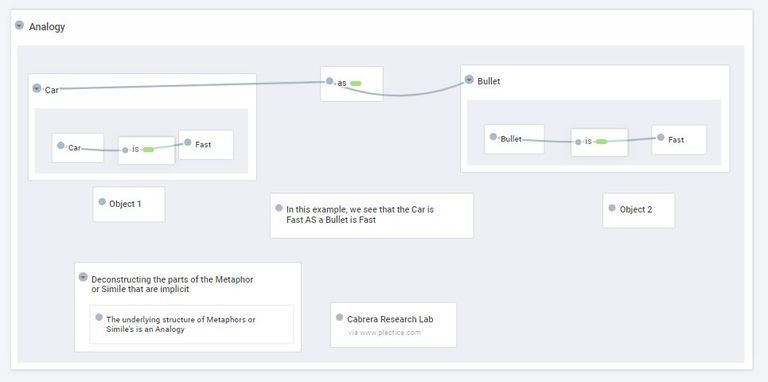The use of metaphors and analogies assist us in connecting the dots. Jane Hirshfield describes them as a way to feel and know something differently. She says that they are a way to talk about one thing by describing something else.[2] Essentially, they give words a way to go far beyond their meaning. Let’s take a look at how metaphors and analogies create the handles to open doors to new understanding.
Cognitive Jigs: Simile, Metaphor, and Analogy
In Systems Thinking Made Simple: New Hope for Solving Wicked Problems, Derek and Laura Cabrera describe cognitive jigs as common underlying structures of systemic thought which can be used over and over again to create meaning and understanding. Let’s take a brief look at the three types of cognitive jigs: simile, metaphor, and analogy.
Simile
The Cabrera’s explain the difference between three specific cognitive jigs in a series of videos found at the Cabrera Research Lab. So, what is a simile? I built a diagram to further my understanding of a simile (using the videos via the Cabrera Research Lab). Let’s take a look.
Metaphor
The “conduit metaphor” explained by Michael Reddy is a great example of how a metaphorical concept can hide an aspect of our experience.[3] Reddy explains how our language about language is structured by this complex metaphor. Let’s take a look at the parts of the “conduit metaphor” then the metaphor itself.
Ideas (or meanings) are objects. Linguistic expressions are containers. Communication is sending.
Reddy explains this metaphor in more detail,
Analogy
The Cabrera’s discussion of analogies as cognitive jigs provide us a remarkable way to view what they call – analogy-technology. They explain that, Furthermore, they provide a simplistic (yet extremely helpful) view of the structure of an analogy: A is to B as/like C is to D.
Let’s take a look at a few examples of innovative metaphors and analogies.
Brain Internet Metaphor
A great resource for using, sharing, and understanding analogies and metaphors was developed as a Wikiversity Learning Project by the Global Education for Sustainable Development found at GlobalESD.org. They offer a list of example analogies and metaphors. Let’s take a look at one: Brain Internet Metaphor. As a society, we typically look to the latest technological advancement to compare the brain to. It’s popular to compare the brain to a computer; however, comparing it to the Internet seems to be more appropriate.[4] In this metaphor, we are referring to the Internet and not the World Wide Web. The Web is merely an application used on the Internet. The Internet, like the brain, is a network of interconnected links.[5] In essence, we can learn more about the brain by comparing it to the vast number of interconnected links within the Internet.
Biomimicry
In her book Biomimicry, Janine Benyus defines Biomimicry as imitating or taking inspiration from nature’s forms and processes to solve problems for humans. Biomimicry is a phenomenal field, one that has the potential to completely reshape our entire reality. The team at GlobalESD.org identifies the following: Biomimicry is adapting the designs of nature to solve the design challenges facing humans. Furthermore, they discuss how we can think of it as a way to develop and refine analogies between nature and society. Benyus demonstrates this by way of analogy. She argues that we should run our businesses like a redwood forest. She says that a mature forest is a fully self-sustaining producer of diversity and abundance. Instead, we seem to run our businesses similar to invasive weeds.
Center of Gravity
Famous military strategist Carl von Clausewitz introduced a physics analogy into warfare in his magnum opus On War. He wrote, The center of gravity in physics is the point where the forces of gravity converge within an object – the spot for which an objects weight is balanced in all directions.[6] For the most part, military strategists have taken this analogy literally. Right or wrong, it does offer some merit. I recently came across an article on this topic from the Naval War College Review. In the article, Lieutenant Colonel Antulio J. Echevarria provides a deep look into the center of gravity analogy. He presented what was, to me, an extremely interesting discussion on where the center of gravity of a boomerang is located. Regarding a boomerang, the center of gravity does not lie on the actual object, but in the V-shaped space between a person’s arms. My question is, if taken literally, is this a more appropriate example of a center of gravity in warfare? Meaning, could the center of gravity be unseen and not visible (i.e. ideology or culture)? This question demonstrates the profound impact an analogy can have on just about anything. Finally, in her TEDEd video The Art of the Metaphor, Jane Hirshfield describes how metaphors give words a way to go beyond their own meaning. She ends her video with a deep and profound metaphor, Featured photo credit: pixabay via pixabay.com



